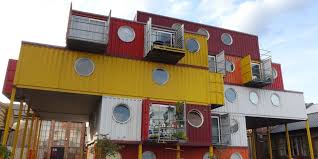Ah, yes. This one was inevitable. Even for those who are new at the idea of looking for alternative or off-grid or, possibly, temporary housing, odds are that you have heard about shipping containers. They seem to be the most commonly talked about option. Why? I'm not entirely sure, to tell you the truth. Compared to the other options I've already discussed, they generally do tend to cost less. They are also seemingly abundant. However, they also take a great deal of work to make them livable.
On average, the going price for a 20 foot container is in the neighborhood of $2,000, but can vary widely. Before I started really looking into this as an option, I had no idea whatsoever that shipping containers are not all created equal. I mean, think about it. When you see them riding on trains, and holding you up in traffic, they all look pretty much the same. When you see cargo ships all loaded up, they all seem perfectly identical, except for the paint job. However, they actually come in several different sizes, the most common being 10', 20', 30', 40', and 50' in length. They're generally 8' wide and roughly 8'6" tall, although there are variances. They are also made from a variety of materials, depending on the original purpose. But the type that is best for making a suitable living environment is "Cor-Ten Steel". They are designed specifically to withstand inclement weather while sitting on a cargo ship. They are going to last longer than other types of continers. It's sturdy enough to live in, but also easy to fix up and customize, relatively speaking.
Where do you go to buy a shipping container? If you are fortunate enough to live close to a shipyard, then you can go down there and ask. More often than not, there are a good deal of containers that cannot or will not be used for actual shipping. This can happen for any number of reasons. Just be sure you know what you're getting, and that you can clean it as it needs. You don't really want to try to live in something that was used to transport toxic waste or anything, right? But there are generally so many containers on hand at any given moment, that the owners at shipyards can become quite desparate to get rid of them. If you're good at negotiating, you could pull in a pretty sweet deal, especially if you want more than one. Another place to look is warehouse districts. Again, they can get anxious to get rid of them if you ask at the right time. There are a great many places online that specialize in selling shipping containers. Now there, you will get a new(er) container, and have more options in sizing. But you're also going to pay a higher price, plus the shipping cost of getting the container to you. But there are also options that you might not think of immediately. Check out Craigslist or Ebay. They do pop up often. In fact, there are currently several listed on Ebay. I saw a 20' go for less than $500 over there not too long ago. Just remember to look at the fine print so you know whether or not they'll ship to you, or if it's pick up only.
Now, what can you do with a shipping container? Honestly, the possibilities are endless. Dig a bit and put it underground, or build a deck around it for a swimming pool. Leave it simple, and, if it's temporary, use it as a garage, workshop, extra storage, or whatever, after you move out. Or make it as elaborate as you want, either as a single container, or with several put together. Cut out sides, alter the roof line, whatever you can think of. I'm not going to get into a lot of detail on this, just because the internet is already so saturated with loads of information out there on using shipping containers as homes. So I'll just leave you this time with a LOT of pictures. Let your imagination go wild!

















No comments:
Post a Comment